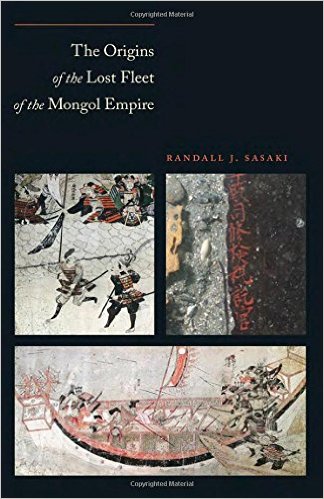The Origins of the Lost Fleet of the Mongol Empire
Randall J. Sasaki
 Despite the growth of nautical archeology over the last forty years, less attention has been focused on the archeology of ships of Eastern Asia—Japan, Korea, and China—than elsewhere.
Despite the growth of nautical archeology over the last forty years, less attention has been focused on the archeology of ships of Eastern Asia—Japan, Korea, and China—than elsewhere.
The Origins of the Lost Fleet of the Mongol Empire, by Randall J. Sasaki, fills part of that gap. The book analyzes wrecks found off Takashima, in Japan. The ships, part of the second Mongol invasion of Japan in 1281, were sunk in the typhoon the Japanese afterwards named the Kamikaze, or Divine Wind.
The long-forgotten wrecks were rediscovered in the 1980s, with research on the finding ongoing since then. An intact wreck was even discovered in in 2011. In 2004-2005, Sasaki, then a graduate student at Texas A&M’s Institute of Nautical Archeology, participated in these studies for his master’s studies.
The book explores the results of his research, examining the origins of the ships wrecked off Takashima. Three different types of ships were found: flat-bottomed lapstrake boats, flat-bottomed carvel craft, and round-bottomed vessels. Sasaki identified both the origins and probable purpose of each type of ship based on its timber and construction (respectively: Korea, the Yangtze River, and Fujian Province).
Sasaki clearly presents the logic behind his conclusions, explaining how the woods and fastenings discovered on the offered clues to their origins. He takes readers on a tour through the shipbuilding techniques of thirteenth-century Korea and Japan. He provides significant and fascinating detail on how shipwrights built the ships that ended up off Takashima.
The book is well illustrated, with maps, period images, modern archeological photographs, and author plans. The mix is well-thought out. It offers readers insight into the events leading up to the invasion and typhoon. The drawings and plans are extremely useful in illustrating the construction and shapes of the ships found.
This book is concentrated very narrowly on one aspect of Asian maritime archeology. If you want to know how Korean and Chinese ships were built during this period, it provides a wealth of valuable information. On the other hand, if your interests have a broader focus, this book may not hold your interest.
For the model-maker, it contains enough information to make a start on building a representative model of a Korean, Yangtze, or Fujian ship. Completing the model requires additional research. For those whose focus is maritime history, it offers a window into the Mongol invasion fleet, including its origins, organization, and loss. For those into marine archeology, it is a fascinating look at how research is done.
While unlikely to interest everyone, those who are interested in this topic will find The Origins of the Lost Fleet of the Mongol Empire a useful addition to their library.
- College Station: Texas A&M University Press, 2015
- 6-1/2” x 9-1/4”, hardcover, 216 pages
- Illustrations, diagrams, maps, bibliography, index. $50.00
- ISBN: 978-1623491949
Reviewed by Mark Lardas, League City, Texas
